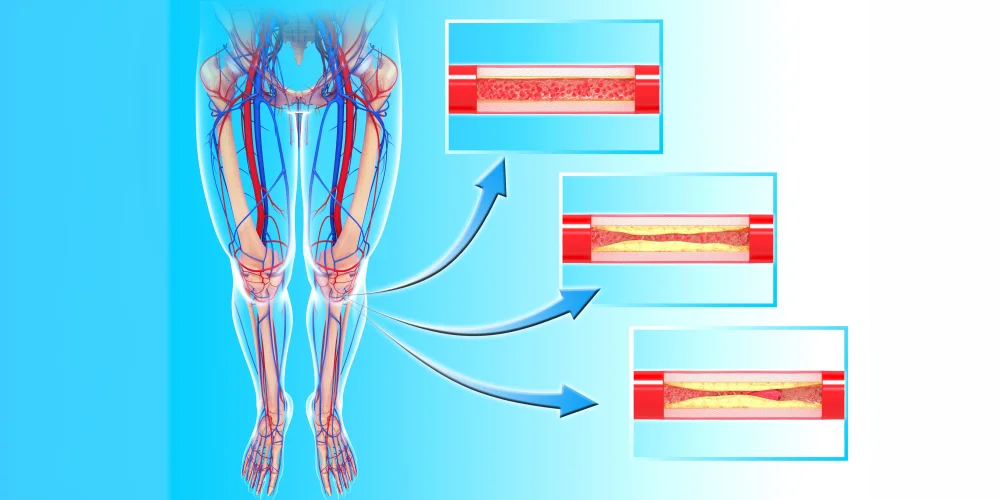Peripheral Artery Bypass Surgery
Peripheral Artery Disease (PAD) and Enhanced Circulation
Peripheral Artery Disease (PAD) is a condition in which the arteries that carry blood to feet and legs get blocked or narrowed, often because of atherosclerosis. This impeded blood flow could cause cramping, pain or fatigue, in legs and, in the worst instances, can lead to ulcers and infections, as well as loss of limbs. Peripheral artery bypass surgery an operation that is that is designed to restore circulation to the affected areas through creating a detour in the blocked arteries. In Chirayu Super Speciality Hospital, our highly skilled vascular surgeons are experts in the most advanced peripheral artery bypass procedures that provide patients with effective treatment for PAD symptoms and assisting them to get back their mobility and enhance the level of living.

What is Peripheral Artery Bypass Surgery?
The procedure of bypassing the peripheral artery an operation that creates a new way for blood to flow around a blockage or narrowed artery within the leg. A graft is utilized to clear the obstruction and could be an artificial tube or healthy blood vessel that is taken from another area of the body. The goal of this procedure is to bring back adequate blood flow to legs. It can relieve symptoms like pain and cramping, and also prevent serious complications. Peripheral bypass is generally advised for those suffering from severe PAD that haven’t been able to respond to other treatments, like treatment or lifestyle modifications.
Who Performs Your Surgery?
Peripheral artery bypass surgery performed at Chirayu Super Speciality Hospital is performed by skilled surgeons in vascular surgery who are skilled in the treatment and diagnosis of peripheral artery diseases. Our surgical team has been trained with the most recent methods and techniques, ensuring the highest standards of care and a successful outcome of surgery. The surgeons collaborate closely with nurses, anesthesiologists and other health professionals to provide compassionate and comprehensive assistance throughout the entire surgical procedure.
Types of Peripheral Artery Bypass Surgery
- Aorto-Femoral bypass : This kind of bypass makes use of the graft technique to redirect blood from the aorta into the femoral arteries of the legs. It is typically done in cases where blockages are more high in the arteries.
- Femoro-Popliteal Bypass : In this method, the bypass graft is inserted between the femoral artery located in the thigh and the popliteal arterial close to the knee. It is commonly utilized to treat blockages in the lower leg.
- Femoro-Tibial bypass : This surgery aims to bypass an artery blocked in the thigh and connecting it to an artery lower in the calf. It is typically done for blockages that cause severe pain to the lower regions of the leg.
- Axillo-Femoral bypass : This bypass makes use of a graft that connects the axillary artery of your chest, to the femoral vein in the groin. It is when the aorta can’t be reached.
Symptoms Indicating the Need for Peripheral Artery Bypass Surgery
- The leg is painful or cramping in the course of physical activity (claudication) that doesn’t get better with rest.
- The wounds aren’t healing and can cause ulcers or abrasions to the feet or legs.
- Numbness or coldness on the feet or legs.
- Skin changes or discoloration on the legs.
- Tissue death or Gangrene because of a low blood flow.
- Consistent symptoms, are present despite lifestyle changes, medications or other treatments.
Diagnosis for Peripheral Artery Bypass Surgery
A diagnosis for PAD usually is based on a thorough physical examination and review of medical background, and imaging tests. The most commonly used diagnostic tests are an Ankle-Brachial Indice (ABI) test that measures blood pressure variations between the ankle and the arm and a Doppler ultrasound test to assess blood flow through the arteries, as well as angiography, which utilizes X-rays and a contrast dye to find obstructions. Based on the degree and the location of the blockages the surgeon who specializes in vascular surgery will suggest bypass surgery for peripheral arteries as the most effective option.
Treatment Process
The process of treatment starts with a comprehensive meeting with a vascular surgeon to discuss symptoms, diagnoses and surgical alternatives. Peripheral artery bypass surgery can be carried out under general as well as regional anesthesia. In the course of the procedure, the surgeon cuts an incision close to the artery that is blocked, then inserts the graft in order to create an alternative route that allows blood to flow and then ensures that the graft’s connection is secure to both sides of the arterial. Following the procedure the patient is closely monitored in a recovery room before being transferred to a hospital area to receive further care and observation. The whole procedure can take some time, based on the severity of the situation.
Care and Recovery After Surgery
Recovery from peripheral artery bypass surgery requires hospitalization that can last between a few days and one week, based on the condition of the patient. Patients might experience minor swelling, pain, or bruises at the site of incisions, which can be controlled by taking pain medications. It is crucial to keep your legs elevated and avoid strenuous exercise and gradually increase physical exercise according to recommendations from the medical team. Regular follow-up appointments are vital to track healing, check for graft function and to avoid any complications. Patients are advised to change their lifestyles including cutting down on smoking, reducing cholesterol, and consuming an eat-plan that is heart-healthy to lower the chance of a further blockage of the arteries.
Advantages of Choosing Our Surgery Services
Expert Vascular Surgeons
Our team includes highly trained vascular surgeons with extensive experience in peripheral artery bypass procedures, ensuring the highest quality care.
Advanced Surgical Techniques
We utilize the latest surgical methods and technologies to provide effective treatment, minimize risks, and enhance recovery.
Best Treatment Plans
We tailor each surgery to meet the specific needs of our patients, ensuring personalized care and optimal outcomes.
What Our Patients Say
Read about our patients positive experiences and how Chirayu Super Speciality Hospital has positively impacted their health and well-being.


If you’re struggling with PAD, I highly recommend Chirayu Hospital. Their expertise and care made all the difference for me.


The results of my surgery have been fantastic. I feel better, and my legs no longer cramp up like they used to.


From diagnosis to recovery, the care I received was exceptional. The surgery relieved my leg pain, and I’m forever grateful.


Peripheral artery bypass surgery at Chirayu has transformed my life. I can walk without pain and feel healthier overall.
Meet Our Medical Specialists
Our skilled vascular surgeons specialize in peripheral artery bypass, providing advanced treatments for improved circulation and pain-free living.
Frequently Asked Questions
Here, we provide answers to some of the most commonly asked questions to help you better understand about our surgery services. If you have any additional questions, please do not hesitate to contact us.
Peripheral artery bypass surgery is a procedure that creates a new pathway for blood flow around a blocked artery in the leg.
Surgery is recommended for patients with severe PAD who have not responded to medication, lifestyle changes, or other treatments.
Potential risks include infection, bleeding, blood clots, and graft failure. Our team takes measures to minimize these risks.
The surgery itself is not painful due to anesthesia. Post-surgery, some discomfort at the incision site is normal but manageable.
Recovery time varies, but most patients stay in the hospital for a few days and gradually return to normal activities within weeks.



